KHALID SHEIK MOHAMMED
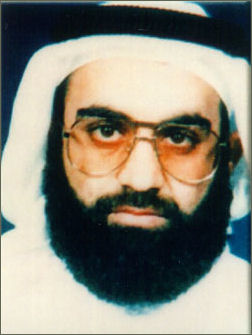
Khalid Sheikh Mohammed Khalid Sheik Mohammed by many estimates ranks third in stature and importance in Al-Qaida after Osama bin Laden and Ayman al-Zawahiri and may have been more pivotal than either of these men pulling off Al-Qaida’s most famous and spectacular attacks. An ethnic Baluchi Pakistani born and raised in Kuwai and educated in part at a small college in North Carolina, Mohammed is regarded as: 1) the mastermind of the attack on the World Trade Center in New York on September 11, 2001; 2) a financier of the embassy bombings in Kenya and Tanzania; and the man who hatched the plans to attack the U.S.S. Cole in Yemen in 2000 and the plot to blow up a dozen American passenger planes over the Pacific in the mid 1990s. Currently under detention and awaiting trial in the United States, he has been sometimes referred to as “The Brain.”
KSM, as he is known, was a flamboyant figure known for dreaming up grandiose plans. He had a $25 million price on his head and considered himself as an independent contractor to Al-Qaida rather a member. According to a U.S. government report: “No one exemplified the model of a terrorist entrepreneur more clearly than Khalid Sheikh Mohammed. Highly educated and equally comfortable in a government office or a terrorist safe house, KSM applied his imagination, technical aptitude and managerial skills to hatching and planning an extraordinary array of terrorist schemes. the ideas included conventional car bombings, political assassinations, aircraft bombing, hijacking, reservoir poisoning and ultimately the use of aircraft as missiles guided by suicide operatives,”
Dina Temple-Raston wrote in the Washington Post: KSM “is equal parts clowning buffoon and evil genius. He cracks jokes one minute and holds courtrooms spellbound with his admissions the next. His ego is legendary. His original Sept. 11 plan included a media event. He wanted to hijack an additional plane, land it at a major U.S. airport and then, from the tarmac, explain to America why it was under attack. Osama bin Laden is said to have diplomatically called that part of the plot a little “too complicated. After nearly a decade in U.S. custody — including four years at CIA black sites, where the United States admits he was waterboarded — KSM doesn’t appear to have changed much. Although he has been out of the violent jihadi scene for years, he still considers himself the sun around which that world revolves. Had the intelligence community understood his ties to al-Qaeda in a more timely fashion... September 11th might never have happened. Instead, as late as 2002, U.S. officials thought KSM was a freelancer and a jihadi financier, not a mastermind of terrorist plots. [Source: Dina Temple-Raston, Washington Post , June 8, 2012]
In June, 2002, U.S. officials first identified Mohammed as the “mastermind” of 9/11. After that he became one of history’s most famous criminals. Yet, unlike Osama bin Laden, he remained essentially unknown.Terry McDermott wrote in The New Yorker: “In the few statements of his that have been made public — a 2002 interview with the Al Jazeera reporter Yosri Fouda, pieces of the United States government’s interrogations of him, Red Cross prison interviews, and his appearances before military tribunals — Mohammed has been cold-bloodedly straightforward. He told Fouda that the Holy Tuesday planes operation, as Al Qaeda called the 9/11 assaults, was “designed to cause as many deaths as possible and havoc and to be a big slap for America on American soil.” Testifying before a military tribunal in 2007, he likened himself to George Washington and boasted that he planned “the 9/11 operation from A-to-Z.” Killing, he said, was simply part of his job: “War start from Adam when Cain he killed Abel until now. It’s never gonna stop killing of people.” In that appearance, he boasted of murdering the Wall Street Journal reporter Daniel Pearl: “I decapitated with my blessed right hand the head of the American Jew, Daniel Pearl, in the city of Karachi, Pakistan. For those who would like to confirm, there are pictures of me on the Internet holding his head.” [Source: Terry McDermott, The New Yorker, September 13, 2010]
See Separate Article KHALID SHEIK MOHAMMED: 9/11, RAMZI YOUSEF AND PLOTS TO BLOW UP PLANES AND THE WORLD TRADE CENTER factsanddetails.com
Book: “The Hunt for KSM: Inside the Pursuit and Takedown of the Real 9/11 Mastermind Khalid Sheikh Mohammed” by Terry McDermott & Josh Meyer (Little, Brown & Co., 2012)
Khalid Sheik Mohammed’s Family
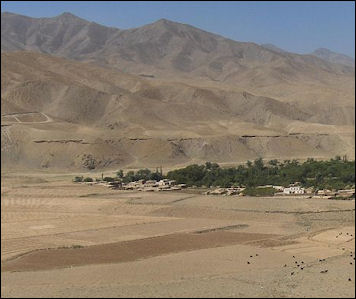
Balochistan Terry McDermott wrote in The New Yorker: “Mohammed’s parents moved to Kuwait from Pakistan in the nineteen-fifties, at the beginning of the country’s oil boom. His father, his father’s brother, and their young families came together; the brothers, both religious men, had been recruited to head mosques. Mohammed’s father became the imam in Ahmadi. The mosque, like most buildings from that era, was built of drab brown brick and today looks as if it could stand some freshening up. Its twin minarets rise above the Kuwait Oil Company corporate reservation (built by the British before the Kuwaitis nationalized the oil industry), a tidy plot of tree-lined streets and white-fenced worker cottages that seems to have been shipped in whole from a greener world.” [Source: Terry McDermott, The New Yorker, September 13, 2010]
“Mohammed’s parents had four children when they arrived in Kuwait. Five more were born after their arrival; Khalid was the second-to-last child and the youngest of four boys. The family travelled on Pakistani passports, but both parents were ethnic Baluchis, from a swath of hard, dry land across the Gulf of Oman from the Arabian Peninsula. Baluchistan, as it has been called for centuries, includes parts of contemporary Iran, Afghanistan, and Pakistan, but existed as an entity long before the boundaries of any of these modern states were drawn.”
The oil money that drew Mohammed’s family transformed Kuwait. At its first formal census, in 1957, the country had a population of three hundred thousand. By 1985, it was nearly six times as large. The boom gave native Kuwaitis a lifelong assurance of comfort: guaranteed jobs, housing, medical care, education, and pensions. Foreign guest workers, known as bidoon — mostly Palestinians, Egyptians, and South Asians — were not eligible for the benefits, though they made up the majority of Kuwaiti residents. The Baluchis were bidoon. For Mohammed’s family, this was a fundamental fact of life.
_svg.png)
Balochistan In the years after Mohammed left Kuwait , his family appears to have scattered across the region. Most of them fled during Iraq’s occupation of Kuwait, in 1990. The only one who remained was a brother-in-law of Mohammed’s, who is now the muezzin, or prayer caller, at the Ahmadi mosque. An older brother, at least two sisters, and some cousins live in Iran, along with Mohammed’s wife and children. One of the children is mentally disabled and another is epileptic, according to a Pakistani cousin. Two of his sons were captured by Pakistani authorities in 2002 and subsequently held in American custody for at least several months; they are now with their mother. The family survives by selling handicrafts, harvesting dates, and keeping a small herd of goats for milk.
Mohammed seems not to have made close friends as a young man. In years of reporting, I did not find a single person from Kuwait or North Carolina who had had any continued contact with him. His most constant companion appears to have been his nephew Abdul Basit Abdul Karim, who helped him tear down the flag at their school in Kuwait.” Later internationally known as Ramzi Yousef, Karim was the man behind the 1993 bombing of the World Trade Center and is credited by some with putting Al-Qaida on the path becoming the worldwide terrorist network that it became.
Early Life and Education of Khalid Sheik Mohammed
Khalid Sheikh Mohammed, according to the information he provided to the Red Cross, was born on April 14, 1965. His father, who was fifty-seven, died four years later, and his three brothers took over his schooling. Khalid was much younger than his oldest siblings and had nieces and nephews his own age. [Source: Terry McDermott, The New Yorker, September 13, 2010]
Peter Finn wrote in the Washington Post: Mohammed — was born in Kuwait, the third son of Pakistani immigrants drawn to the oil-rich emirate, where his father became the imam of a mosque serving Pakistanis. Mohammed said he was a radical from a young age, asserting in a statement he gave to the CIA after his capture that he and nephew Ramzi Yousef — convicted in the 1993 attack on the World Trade Center — had torn down the Kuwaiti flag at their elementary school. He became involved in radical activities when he joined the Muslim Brotherhood at the age of 16. By 16, Mohammed had joined the Muslim Brotherhood, an Islamist group, and become "enamored of violent jihad at youth camps in the desert," according to a detailed profile in the 9/11 Commission Report. [Source: Peter Finn, Washington Post, November 14, 2009]
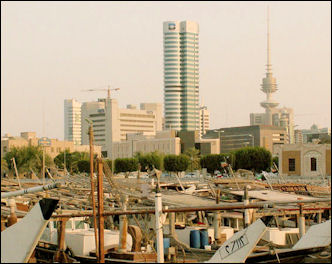
Kuwait city Terry McDermott wrote in The New Yorker: “Badawiya, the neighborhood where Khalid Sheikh Mohammed grew up, sits between the sand and the sea on the southernmost edge of Fahaheel, a suburb of Kuwait City. The neighborhood mosque overlooks a mile-wide field of rubble and weeds, a buffer against the Shuaiba petrochemical complex, whose flare stacks sputter and glow around the clock. Just a few miles to the west are Ahmadi, the administrative center of the Kuwait Oil Company, and the bountiful Burgan oil field, where the stores of oil that essentially created modern Kuwait were discovered in 1938. [Source: Terry McDermott, The New Yorker, September 13, 2010]
Mohammed — and his nephews attended Fahaheel Secondary School, in a three-story brick building that accommodated as many as twelve hundred boys. (Girls attended separate institutions and did not progress beyond secondary school.) Mohammed, like his brothers, was a superior student. “He was one of my smartest students in the science section,” Sheikh Ahmed Dabbous, a family friend and a teacher at the school, said. He was also rebellious; he told interrogators that he and his nephew Abdul Basit Abdul Karim (later known as Ramzi Yousef) once tore down the Kuwaiti flag from atop their schoolhouse. The school had a diverse student body — Kuwaitis, Palestinians, Egyptians, and Baluchis — but the groups were not encouraged to mix. Sports clubs, for example, were formed for the exclusive membership of Kuwaitis.
“Most of the teachers in the Kuwaiti public schools that Mohammed attended were Palestinians, who at the time made up the largest group of expatriates in Kuwait. At one point, there were an estimated four hundred and fifty thousand Palestinians in Kuwait, threatening to outnumber the natives. Kuwait became a center of Palestinian political activism. Yasir Arafat worked there as a civil engineer, and Khaled Meshal, a founder of Hamas, graduated from Kuwait University and taught school in Kuwait City. Fatah, the Movement for the National Liberation of Palestine, was founded in Kuwait, in the late nineteen-fifties. Palestinians in Kuwait, another Baluchi who grew up there said, were considered forsaken people, suffering at the hands of Israel and the U.S.
Khalid Sheik Mohammed and the Muslim Brotherhood
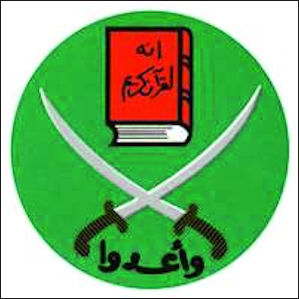
Muslim Brotherhood Emblem In 1979, two events transformed the Muslim world: Shiite Islamists led by Ayatollah Khomeini overthrew the Shah of Iran; and the Soviet Union invaded Afghanistan and installed a puppet government. Terry McDermott wrote in The New Yorker: Mohammed’s older brother Zahed became a student leader of the Brotherhood at Kuwait University. When Mohammed was sixteen, he told American interrogators, he followed Zahed’s lead and began attending the Brotherhood’s desert camps. It was there that he became enamored of the idea of jihad and studied the ideology — anti-Western, anti-Semitic, anti-modern — of Sayyid Qutb, the Brotherhood’s most influential theorist. [Source: Terry McDermott, The New Yorker, September 13, 2010]
The Brotherhood, founded in Egypt in the nineteen-twenties, denounced the iniquities of the modern world and called for a return to a strict interpretation of Islam. The Kuwaiti government tolerated the Brotherhood, which by the nineteen-eighties was dominated by Palestinians, as a hedge against potential threats from leftist groups; in one of the persistent oddities of political life in much of the Middle East, the Brotherhood was at times outlawed and yet still allowed to put up candidates for election. Daniel Byman, a professor at Georgetown University and a staff member on the 9/11 Commission, says that this sort of ambivalence allows governments to maintain control of extremist groups. “You keep everyone semi-illegal,” Byman says. “You always have an excuse to crack down. “Go ahead and run that school and hospital.” Five years later you want to clip their wings? “Oh, you don’t have a permit? Too bad.” “
Khalid Sheik Mohammed in the United States
After high school, Mohammed enrolled at Chowan College (now University) in North Carolina. He transferred after one semester to North Carolina Agricultural and Technical State University in Greensboro, where he earned a degree in mechanical engineering in 1986. The 9/11 Commission Report said Mohammed did not attract attention in the United States for any extremist beliefs.[Source: Peter Finn, Washington Post, November 14, 2009]
Terry McDermott wrote in the The New Yorker: “When Mohammed graduated from high school, the family decided that they could afford to send only one boy abroad; as bidoon, they did not qualify for the generous government scholarships. The older brothers chose Khalid, and he left home in 1984...In January, 1984, Mohammed, travelling on a Pakistani passport, arrived in tiny, remote Murfreesboro, North Carolina, to attend Chowan College, a two-year school that was advertised abroad by Baptist missionaries. Mohammed listed his brother Zahed as his father on the enrollment forms. His bill, $2,245 for the spring semester, was paid in full the day of matriculation, January 10th. Murfreesboro — population about two thousand, with no bars and a single pizza shop — must have seemed intensely foreign. There were dusky rivers meandering through dense pine forests, cotton fields, and tobacco patches. Not a sand dune in sight. [Source: Terry McDermott, The New Yorker, September 13, 2010]

Chowan University website grab — Chowan did not require the English-proficiency exam that was then widely mandated for international students, so foreign enrollees often spent a semester or two there to improve their English, then transferred to four-year universities. By the nineteen-eighties, the foreign-student contingent was dominated by Middle Eastern men, about fifty of whom were enrolled each year. Mohammed, though he was Pakistani by heritage, spoke Arabic, and was integrated into the Arab group. Arab students who were there at the time said they were the butt of jokes and harassment, in the anti-Muslim era that followed the Iranian takeover of the U.S. Embassy in Tehran, in 1979. The local boys called them Abbie Dhabies, a play on Abu Dhabi, one of the states of the United Arab Emirates. They were required, along with all the other students, to attend a weekly Christian chapel service.
“A group of Middle Eastern men lived in Parker Hall, a brick dormitory with views of Lake Vann, a small pond on campus. They often cooked, ate, and prayed together. They left their shoes in the dormitory corridor, an apparently irresistible target for fellow-students, who sometimes threw the shoes in the lake. At other times, students propped garbage pails filled with water against their doors, then knocked and ran away. When the young men answered, water flooded in.
“Mohammed did well in the pre-engineering curriculum, taking classes in English and chemistry. After one semester, he left for North Carolina Agricultural & Technical State University, in Greensboro, a historically black college on the Piedmont plain, in the central part of the state, and began to study mechanical engineering; one of his nephews came to A. & T. at the same time. Mohammed developed a dislike for the U.S. in his time here. He told investigators that he had little contact with Americans in college, but found them to be debauched and racist. He also said that he spent a brief time in prison for failing to pay bills. A classmate, Sami Zitawi, told me in 2003 that it wasn’t uncommon for one of the students to spend a night in the county jail, in Greensboro. He himself was hauled there for failing to pay parking tickets.
Khalid Sheik Mohammed Radicalized by His Experience in the United States?
Terry McDermott wrote in The New Yorker: “Mohammed completed his college requirements in three years, and in December, 1986, both he and his nephew graduated with engineering degrees. Mohammed returned home to Kuwait, where his old high-school teacher Sheikh Ahmed Dabbous sought him out and found him radically changed. “When he goes there, he sees Americans don’t like Arabs and Islam,” Dabbous told me in 2003. When Dabbous asked why, Mohammed told him, “Because of Israel. Most Americans hate Arabs because of this.” Dabbous said, “He’s a very normal boy before — kind, generous, always the smiling kind. After he came back, he’s a different man. He’s very sad. He doesn’t speak. He just sits there.” He told Dabbous he was upset that Americans hated Islam. “I talked to him, to change his mind, to tell him this is just a few Americans,” Dabbous said. “He refused to speak to me about it again. He was set. When Khalid said this, I told him we must meet again. He said, “No, my ideas are very strong. Don’t talk with me again about this matter.” [Source: Terry McDermott, The New Yorker, September 13, 2010]
A CIA document released in 2009 said Mohammed's "limited and negative experiences in the United States almost certainly propelled him on his path to become a terrorist." Peter Finn wrote in the Washington Post: “Mohammed lost his driver's license in North Carolina after he got into an accident while driving without insurance, according to a U.S. official. He was later arrested in Kentucky and spent a night in jail for unpaid tickets and for driving with a revoked license. He told the CIA his contacts with Americans confirmed his view that the United States was a "debauched and racist country," according to the agency document. Later, at Guantanamo Bay, he told one person who had contact with him that, in all his time in the United States, he had never touched an American, not even to shake hands.” There were also reports he threatened to assassinate a radical rabbi. [Source: Peter Finn, Washington Post, November 14, 2009]
Khalid Sheik Goes to Pakistan-Afghanistan in the 1980s
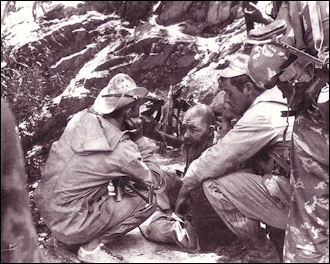
Mujahideen in Afghanistan After college, in 1986, Mohammed traveled to Pakistan, where one of his brothers worked for a Kuwaiti charity, and immersed himself in the world of the anti-Soviet mujaheddin. He went to Afghanistan and also participated in struggle in Bosnia in 1992.
Terry McDermott wrote in The New Yorker: “Before Mohammed left for the U.S., his brother Zahed had started working for a Kuwaiti charity called Lajnat al-Dawa al-Islamia, the Committee for Islamic Appeal. In 1985, L.D.I. asked Zahed to move to Peshawar, Pakistan, to run war-relief operations in support of the Afghan resistance. L.D.I. was among the largest of more than a hundred and fifty aid organizations that set up offices in Peshawar. It had more than twelve hundred employees in Pakistan and Afghanistan and a four-million-dollar annual budget, which funded hospitals, clinics, and Koran-study centers. Two brothers, Aref and Abed, had followed Zahed to Peshawar. Almost immediately after returning from America, Mohammed, unable to find work at home, went to join them. [Source: Terry McDermott, The New Yorker, September 13, 2010]
“When he arrived in Peshawar, in 1987, it was a place full of spies and adventure. The buccaneering Texas congressman Charlie Wilson periodically rolled through carrying American gifts, the latest of which — stinger missiles — had just arrived. The fight against the Soviets had been going on for eight years, and the resistance was beginning to sense the prospect of victory. “The Afghans were ecstatic,” a Western diplomat who was stationed in Peshawar at the time said. “They thought they were really doing some stuff over there.”
“As the head of an influential charity, Zahed was a figure of importance. He worked out of an office on Arbab Road, in University Town, the newest and most Westernized neighborhood in the city, and knew virtually everyone significant in town: resistance leaders, their Arab funders, Pakistani spies, journalists. Mohammed and his brother Abed went to work for Abdul Rasul Sayyaf, the leader of Ittihad e-Islami, one of the Afghan-refugee political parties headquartered in Peshawar. Abed worked at the Party’s newspaper, and Mohammed taught engineering at Sayyaf’s University of Dawa al-Jihad, situated about thirty miles east of Peshawar. (A little farther down the main road was the mosque and madrassa where many Taliban leaders were schooled.) Dawa al-Jihad was a rough but functioning college; as many as two thousand students came to learn engineering, medical technology, and literature, and also to train at jihadi camps that Sayyaf ran. Next to the school, separated by high mud walls, was the Jalozai refugee camp, home to more than a hundred and twenty thousand Afghans. Mohammed also worked there, helping to organize the delivery of supplies.
“Mohammed and his brothers became part of the small community of foreigners in Peshawar, which included some of the most influential figures of militant Islam. Among them was Abdullah Azzam, the Palestinian who essentially created the notion of radical jihad, redefining what had been a personal struggle for righteousness as a fight against infidels. Ayman al-Zawahiri, a founder of the Egypt-based group Islamic Jihad, who later became the second-in-command of Al Qaeda, was also there, as was Osama bin Laden. Most of the men prayed at a small mosque called Saba-e-Leil, on a dead-end alley off Arbab Road, not far from Zahed’s office. Mohammed married a Pakistani woman he met at Jalozai; Zahed is said to have married her sister.
KSM After Pakistan-Afghanistan in the 1980s
By the time the Soviets left Afghanistan, Terry McDermott wrote in The New Yorker, many of the original Arab mujahideen were gone, including bin Laden, who had gone home to Saudi Arabia in 1989, leaving behind a fledgling Al Qaeda to coördinate jihad activities. Zahed stopped working for L.D.I. and went to the United Arab Emirates. (He was deported from the U.A.E. in 1998 for his involvement with the Muslim Brotherhood, and moved to Bahrain, where he now works as an executive at a large business conglomerate. When I found him there this spring, at a spacious house, with children’s toys and bicycles strewn around outside, he threatened to sue me for invading his privacy.) [Source: Terry McDermott, The New Yorker, September 13, 2010]

Jamaat-e-Islami Pakistan flag “Mohammed, with the sponsorship of a member of the ruling family of Qatar, Abdullah bin Khalid al-Thani, moved his family to Doha, the capital. At a farmhouse outside of town, Thani provided what amounted to a hostel for former mujahideen. An American government official in the region at the time recalled that Thani told him, “These people went out there and fought for their faith and now they’ve been abandoned by their countries and I feel sorry for them.”
“Mohammed was given a position as an engineer in the water department of the tiny emirate’s public-works ministry. How much time he spent at his job is unclear, but it was apparent that he hadn’t quit the fight. He established a small fund-raising network, soliciting wealthy men around the Gulf, then bundling modest amounts of money — perhaps a few hundred dollars at a time — and shipping it on. Fund-raising for religious causes is ubiquitous in the Gulf; Mohammed simply adapted it to the cause of militant jihad. He was in and out of the country, the American official said, popping up in the U.A.E., Bahrain, Pakistan, and, occasionally, Kuwait. Still, his name was almost never mentioned in broader counterterrorism discussions, and it wasn’t evident that he was anything more than a bit player. “We knew he was sort of in possession of money and sending it somewhere,” the official said.”
Khalid Sheik Mohammed’s Schemes, Attacks and Beheading of Daniel Pearl
Dina Temple-Raston wrote in the Washington Post: “He managed to turn himself into nothing less than the Kevin Bacon of terrorism. Nearly every major plot leveled against the United States from 1990 until years after the 2001 attacks had fewer than six degrees of separation from KSM. Either his family was involved, or his financing network coaxed something along, or he himself played a key role. His nephew Ramzi Yousef dreamed up the 1993 World Trade Center bombing. A KSM intimate partly financed the nightclub bombings in Bali, Indonesia. And the early reconnaissance for a 1995 plot to blow up a dozen American-flagged jetliners over the Pacific, according to McDermott and Meyer, was done by KSM himself. At various times during his captivity, KSM has confessed to a role in nearly three dozen plots. They ranged from aspirational — mulling the assassination of the pope and President Bill Clinton — to real horrors such as the murder of Wall Street Journal reporter Daniel Pearl.[Source: Dina Temple-Raston, Washington Post , June 8, 2012]
AP reported: “In his testimony to a military tribunal at Guantanamo Bay, released in redacted form by the Pentagon on Wednesday, Mohammed claimed involvement in 31 attacks and plots. Some are almost surely true. He was the mastermind of the 9/11 jetliner attacks and, in their wake, certified his bloodthirst by personally beheading Wall Street Journal reporter Daniel Pearl — bragging about it on the Internet then and in the testimony transcript..."I decapitated with my blessed right hand the head of the American Jew, Daniel Pearl, in the city of Karachi, Pakistan," he said. "For those who would like to confirm, there are pictures of me on the Internet holding his head?... His operations ranged from his admitted involvement in the 1993 attack on the World Trade Center, as well as a failed scheme known as Bojinka to bring down 12 Western airliners in Asia — claims that are well documented. Less certain is his claimed role in the October 2002 bombings that killed 202 people in Bali, Indonesia, and aborted plots to assassinate former U.S. presidents and Pope John Paul II. [Source: AP, March 16, 2007]

Daniel Pearl Dina Temple-Raston wrote in the Washington Post: KSM hadn’t initially been aware that the Pakistan bureau chief of the Wall Street Journal had been abducted by local hoods. “The kidnappers, panicked that they had gotten in over their heads, had contacted Al Qaeda colleagues of KSM, offering Pearl to them,” the authors write. “Al Qaeda offered $50,000 for him and, because it was in Karachi and Karachi was KSM’s territory, asked him to take possession of the prize.” [Source: Dina Temple-Raston, Washington Post , June 8, 2012]
Terry McDermott wrote in The New Yorker: “ A video posted on the Internet showed Pearl’s severed head held by what some believe is Mohammed’s hand, recognizable by the “extra meat” on his ring finger, as a Filipino investigator once put it. There remains a debate about whether Mohammed in fact committed the killing. Pakistani investigators now think that he did, though he had nothing to do with the initial kidnapping; that was the work of what one investigator called a “mishmash” of local jihadis. [Source: Terry McDermott, The New Yorker, September 13, 2010]
See Separate Article KHALID SHEIK MOHAMMED: 9/11, RAMZI YOUSEF AND PLOTS TO BLOW UP PLANES AND THE WORLD TRADE CENTER factsanddetails.com
Capture and Arrest of Khalid Sheik Mohammed
There was a ten year hunt — from 1993 to 2003 — to capture KSM. On March 1, 2003, Mohammed was captured without incident at 3:30am by 20 Pakistani security agents who raided a villa in a upper class neighborhood in Rawalpindi, where he was sleeping. His hide out was discovered by tracking cell phone calls and getting information from other terrorist suspects. The Pakistani officers were initially not sure they had the right man. One agent told Newsweek, “He wasn’t at all like his photos; he seemed fat and droopy.” At the time of his arrest Mohammed was said to be planning attacks in the United States, possibly at gas stations, power plants, bridges and hotels. He also been involved in trying to get a hold of radioactive material and toxins for weapons of mass destruction.
Mohammed was captured with help of information derived from the interrogations of Al-Qaida member Abu Zubaida and from tips from an informant who collected the $25 million ransom. Before the arrest the informant was sitting with Mohammed in Pakistan and excused himself just long enough to text U.S. officials a simple message: “I am with KSM.” Mohammed was captured hours later. [Source: Dina Temple-Raston, Washington Post , June 8, 2012]
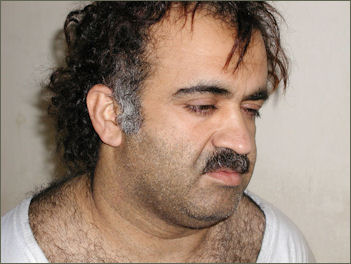
Khalid Sheik Mohammed
at the time of his arrest Mohammed was traced using a cellphone chip he had acquired from Switzerland. The prepaid chip, or SIM card, was purchased anonymously, but European intelligence officials traced calls to it from a suspected terrorist in Germany and later determined that it was being used by Mohammed. He was caught even though he practiced extreme caution in his telephone habits; he rarely used the same cellphone more than once and had others take calls on his behalf, but he tripped up by relying on the same chip.
In their book “The Hunt for KSM”, Terry McDermott and Josh Meyer wrote: “A member of the CIA team had taken photos of KSM right after his capture, including one in which he looks into the camera, with his eyebrows raised nearly to his hairline.” But apparently, the CIA didn’t think the photos were sufficiently unattractive. A CIA man in Washington “asked if there were any other photos available. The agent messed up KSM’s hair then took another photo. The result was the famous image of KSM — thickset, glowering, wild-haired, half dressed in his nightshirt — his first introduction to most of the rest of the world.” [Source: Dina Temple-Raston, Washington Post , June 8, 2012]
Terry McDermott wrote in the The New Yorker: Mohammed’s “capture likely owed something to the technical capacities of American surveillance, but the big break came by the oldest of means: betrayal. The U.S. had offered a twenty-five-million-dollar reward for Mohammed’s capture, and a cousin tipped off authorities about his location. The man, an Iranian Baluchi, has been resettled with his money, presumably in the United States. “Even his family is his enemy now,” a Pakistani relative said of the cousin. “His father says, “If he returns, we will kill him.” [Source: Terry McDermott, The New Yorker, September 13, 2010]
“It is an article of faith among Mohammed’s family members, several of whom have been arrested on suspicion of coöperating with him, that he has been falsely accused. “Just think about it,” the cousin said. “How can it be that such a big tower, merely by being hit by a plane, it gets demolished? At the very least, something has been placed at its foundation which would cause the collapse. This was a Jewish conspiracy.” Relatives have gone to court to reverse what they allege was Pakistan’s illegal extradition of Mohammed to American authorities, but his wife has asked them to stop their efforts. The cousin said she told him, “It’s in God’s hands.”
Torture and Imprisonment of Khalid Sheik Mohammed
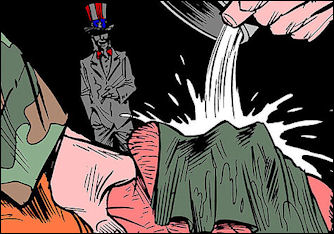
Waterboarding The Washington Post reported: “Khalid Sheik Mohammed was subjected to the CIA's harshest interrogation methods while he was held in secret prisons around the world for more than three years. According to a New Yorker article by Jane Mayer published in August 2007, Washington sources said that Mohammed said he was held naked in his cell, questioned by female interrogators to humiliate him, attached to a dog leash and made to run into walls, and put in painful positions while chained to the floor. Mohammed also said he was "waterboarded" — a simulated drowning — in addition to being held in suffocating heat and painfully cold conditions. Mohammed's captors also told him shortly after his arrest in March 2003: "We're not going to kill you. But we're going to take you to the very brink of your death and back," the article said. [Source: Josh White, Julie Tate and Joby Warrick, Washington Post, August 5, 2007]
Peter Finn wrote in the Washington Post: Mohammed “was quickly whisked out of Pakistan to a CIA "black site." Mohammed, who was waterboarded 183 times in his first month in captivity, said he lied to his interrogators, or told them what he thought they already knew, to stop the torment. In time, he also cooperated with the CIA and became what the agency described as the "preeminent source" on al-Qaeda. [Source: Peter Finn, Washington Post, November 14, 2009]
“Defenders of Bush administration interrogation policies have pointed to the intelligence Mohammed provided to justify the use of methods such as waterboarding. Others, including some CIA officials, say that there is no proof of cause and effect, and that the voluminous material amassed from Mohammed could have been acquired without coercion, specifically through the measured exploitation of his extraordinary ego.”
Mohammed spent more than three years in CIA's secret prisons and has been held at Guantanamo Bay since September 2006. Peter Finn wrote in the Washington Post: “He has spent most of his time at Guantanamo Bay in prayer or reading in his cell. The routine has been broken only by visits to the gym, where he likes to jog in small circles, or conversations in the yard with the detainee in the adjoining space... But his time in prison has been marked by moments of despair, according to officials familiar with his detention. Those moments include the time he was given photographs of his children, two of whom were captured with him but now live... with his wife. [Source: Peter Finn, Washington Post, November 14, 2009]
Terry McDermott wrote in The New Yorker: “Since 2006, Khalid Sheikh Mohammed’s family has periodically received letters from him, sent from his cell at the Guantánamo Bay detention center. According to rules established by the American military, the correspondence must fit on a five-inch-by-six-inch portion of a pre-printed form, and its content is restricted to the familial and personal; all else is stricken by censors.” Mohammed “mostly sends good wishes to his wife and children, who are now living in southeastern Iran, and to other relatives. He makes repeated references to his Islamic faith and the beneficence of Allah and his prophet. In photographs that accompanied one of the letters, Mohammed appeared shrunken from the man in the famous image taken the day of his capture. [Source: Terry McDermott, The New Yorker, September 13, 2010]
Trial of Khalid Sheik Mohammed
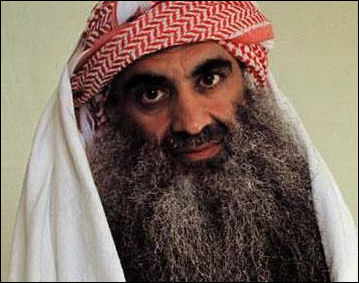
Khalid Sheik Mohammed in July 2009 In 2008 Khalid Sheik Mohammed was charged with murder and war crimes in connection with the September 11 attacks. The Pentagon has said it would seek the death penalty. In his first court appearance, appearing for the first time in five years, Mohammed said in June 2008 he would welcome becoming a martyr when a judge told him he faced the death penalty. Mohammed admitted during a military hearing to being the "mastermind" of the September 11, 2001 attack on the World Trade Center. Mohammed had said at the start of his first trial that he intended to plead guilty and his four co-defendants indicated they would abandon their defense as well.
In November 2009, the Obama administration said Mohammed and four coconspirators would be tried a court in New York City near the site of the September 11 attack. Many lawmakers and New Yorkers opposed the decision for security reasons. There were concerns the trial might make New York the target of another attack, By some estimates the cost of thr trial and security for could exceed $200 million. There were also doubts about whether the defendants could be found guilt in a civilian court, considering many of their basic rights had been denied. All five were held in secret prisons and some endured waterboarding and other “enhanced interrogation techniques” that bordered on torture.
In April 2011 the Obama administration reversed itself and announced Mohammed would be tried at Guantanamo in a military tribunal not a civilian court. In April 2012, the U.S. Defense Department said the trial would go ahead at Guantanamo. The five will be tried together on capital charges that include terrorism, conspiracy, hijacking and murder, making them eligible for the death penalty if convicted. The arraignment began in May, 2011. [Source: AP, April 4, 2012]
Behavior of Khalid Sheik Mohammed in His Trial
In May 2012, Dina Temple-Raston wrote in the Washington Post, Mohammed, “walked into a military courtroom at Guantanamo Bay, Cuba, and tried to wreak havoc. He cracked jokes with his four co-defendants, ignored the judge when he addressed him and spent part of the proceedings reading a magazine. After a 13-hour arraignment, he refused to enter a plea. "To be treated as a common criminal is the last thing Khalid Sheik Mohammed wants," Tom Malinowski, head of the Washington office of Human Rights Watch, told the Washington Post. "It disintegrates the warrior mystique that al-Qaeda promotes to sustain itself — a mystique that a military trial would have reinforced." [Source: Dina Temple-Raston, Washington Post , June 8, 2012]
Describing his behavior at early hearings Terry McDermott wrote in The New Yorker: “In the hearing room, Mohammed and his four co-defendants sit at tables in separate rows, with Mohammed always in the front. Seated with them are their translators, lawyers, and sometimes paralegals — as many as six people in a row. Mohammed does not always rely on a translator in court and has fired his lawyers, so he is sometimes seated at his table with just one other person, a civilian lawyer who serves as his personal representative but not his defense counsel. (This didn’t stop Mohammed from writing a critical memo to the judge, in 2008, titled “Better Translation.”) [Source: Terry McDermott, The New Yorker, September 13, 2010]
“His behavior in court has sometimes been bizarre. Once, he stood during the proceedings to chant Koranic verses aloud. After the judge repeatedly told him that he was out of order and had to stop, he blurted “O.K.” and quit, provoking laughter throughout the courtroom. J. D. Gordon, a former spokesman for the Department of Defense who is now a senior fellow at the Center for Security Policy, witnessed nearly all of Mohammed’s court appearances. “At times, it’s almost like theatre,” Gordon said. “He switches back and forth from very serious and devout to kind of a clown. I think he does that deliberately to draw people in, to charm them in some way, or to influence them. It’s all calculated.”
Image Sources: Wikimedia Commons
Text Sources: New York Times, Washington Post, Los Angeles Times, Times of London, The Guardian, National Geographic, The New Yorker, Time, Newsweek, Reuters, AP, AFP, Wall Street Journal, The Atlantic Monthly, The Economist, Global Viewpoint (Christian Science Monitor), Foreign Policy, Wikipedia, BBC, CNN, NBC News, Fox News and various books and other publications.
Last updated July 2012
